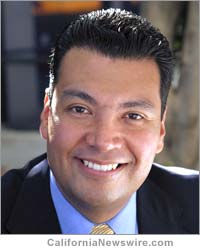 SACRAMENTO, Calif. /California Newswire/ — Calif. Governor Jerry Brown today signed Senate Bill 135 by Senator Alex Padilla (D-Pacoima), which requires that the Office of Emergency Services develop a comprehensive statewide earthquake early warning system to alert Californians in advance of dangerous shaking.
SACRAMENTO, Calif. /California Newswire/ — Calif. Governor Jerry Brown today signed Senate Bill 135 by Senator Alex Padilla (D-Pacoima), which requires that the Office of Emergency Services develop a comprehensive statewide earthquake early warning system to alert Californians in advance of dangerous shaking.
“I applaud Governor Brown for his vision and leadership. We live in earthquake country. He understands that when it comes to earthquakes in California, it is not a matter of if, but when,” said Senator Alex Padilla. “With Governor Brown’s signature, the process of developing a statewide earthquake early warning system has begun,” said Senator Alex Padilla.
“When the system is up and running, Californians will be provided critical seconds to take cover, assist loved ones, or pull over safely to the side of the road. It will allow time to stop a train and power down critical infrastructure. Most importantly, it will save lives,” said Senator Alex Padilla.
“California’s best science and technology will be used to detect seismic activity and alert people in advance of destructive shaking. An early warning system will also help public safety personnel identify and respond more quickly to areas hardest hit by a quake,” Padilla added.
“We need to develop this system without delay. California is going to have an earthquake early warning system, the question is whether we have one before or after the next big quake,” Senator Padilla said.
California presently has a demonstration earthquake early warning system called the California Integrated Seismic Network (CISN). A fully developed system as required by the new law would process data from an array of sensors throughout the state, detect the strength and the progression of an earthquake, alert the public within seconds and provide up to 60 seconds advanced warning before potentially damaging ground shaking is felt. The beta-system worked successfully in March, providing seismologists a 30 second warning of a 4.7 magnitude temblor centered in the Riverside County desert.
Specifically, SB 135 directs the Office of Emergency Services, in collaboration with the California Seismic Safety Commission, California Institute of Technology (Caltech), the California Geological Survey, the University of California Berkeley, the United States Geological Survey, and others, to develop a comprehensive statewide earthquake early warning alert system in California. The Office of Emergency Services would have until January 1, 2016 to identify funding for the system. The initial cost estimate to build a statewide system is $80 million.
About 90% of the world’s earthquakes and over 80% of the world’s strongest quakes occur along the Pacific Ring of Fire. The Ring of Fire includes the very active San Andreas Fault zone here in California. For example, earlier this year, there was a 5.7 earthquake in Northern California, an 8.2 earthquake in Russia, a 7.4 earthquake in Tonga and a 6.8 earthquake off the coast of Chile. Japan, Taiwan, Mexico, Turkey, Romania, Italy and China either have or are working on earthquake early warning systems.
In January, the California Institute of Technology and the Japan Agency for Marine-Earth Science and Technology published a study concluding, for the first time, that a statewide California earthquake involving both the Los Angeles and San Francisco metropolitan areas may be possible. The Uniform California Earthquake Rupture Forecast released in 2008 predicted a 99.7 % likelihood of a magnitude 6.7 earthquake in California in the next 30 years and a 94% chance of a magnitude 7.0.
Japan’s earthquake early warning system provided the public with critical advanced warning of the 9.0 magnitude Tohoku earthquake in March 2011. Earthquake warnings were automatically broadcast on television and radio, and 52 million people received the warning on their smartphones. Millions more downloaded the early warning app after the quake to receive warnings in advance of large aftershocks. The system brought bullet trains safely to a stop, and triggered the automatic shutdown of operations at critical companies. A professor at the University of Sendai received a text message of the warning and was able to warn his students to duck for cover before the shaking began and the light fixtures fell from the ceiling.
At a press conference in January at the Caltech Seismological Laboratory Senator Padilla announced his plans to introduce SB 135 and have it signed into law by October.
Senator Alex Padilla, 40, graduated from MIT with a degree in Mechanical Engineering. He currently serves on the Board of MIT and is President of the National Association of Latino Elected and Appointed Officials. He is Chair of the Senate Energy, Utilities and Communications Committee and represents the more than 1,100,000 residents of the 20th State Senate District in Los Angeles.















